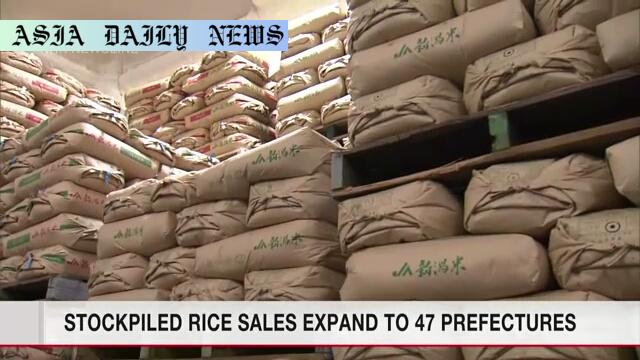Stockpiled Rice: Japan’s agriculture ministry announces the nationwide expansion of stockpiled rice sales to ensure steady supply.

Introduction: Addressing Rice Supply Amid Rising Prices
Japan’s agriculture ministry has taken a significant step in addressing soaring rice prices by expanding stockpiled rice sales to all 47 prefectures. This decision, set to launch nationwide on Friday, marks an essential effort to ensure food security and provide consumers with a steady supply of rice. The sales began at 3,731 retailers earlier this week, spanning supermarkets and convenience stores, with a few exceptions. By making stockpiled rice widely available, the government aims to alleviate public concerns over escalating retail prices.
Nationwide Expansion and Distribution Challenges
The announcement highlights a nationwide rollout to all prefectures, with Okinawa scheduled to receive stockpiled rice as early as Friday. This effort, achieved through no-bid contracts, underscores the urgency of addressing inflationary pressures on essential goods. However, some retailers are yet to receive their grain allocation, and supply chain constraints have resulted in stores selling out quickly. The government remains focused on overcoming these logistical issues and streamlining the distribution process to ensure that the initiative benefits all consumers.
Proactive Measures: Imported Rice Auctions
To further stabilize the rice supply chain, Agriculture Minister Koizumi Shinjiro revealed plans to expedite the auction of imported rice. These auctions are scheduled to begin on June 27, with approximately 30,000 tons out of 100,000 tons of imported table rice set for bidding. This proactive move is expected to bolster the domestic supply, as the imported grain is anticipated to arrive in Japan by September. The government’s multi-pronged approach, combining domestic stockpile distribution with international imports, demonstrates its commitment to mitigating the adverse effects of rising consumer costs.
Addressing Consumer Impact and Market Outlook
Soaring rice prices have significantly impacted households across Japan, necessitating interventions to ensure affordability. By broadening access to stockpiled rice and accelerating imports, the government aims to strike a balance between demand and supply. Experts anticipate that the expanded availability of rice will have a stabilizing effect on market prices over time. Furthermore, this initiative sends a strong message about the importance of food security during periods of economic uncertainty, cementing the government’s role as a key player in market stabilization.
Conclusion: A Comprehensive Strategy
In conclusion, Japan’s efforts to expand stockpiled rice sales nationwide demonstrate a comprehensive strategy aimed at addressing the challenges posed by rising prices and supply chain disruptions. By combining domestic and international measures, the government is proactively ensuring that rice—a staple for millions of Japanese households—remains accessible and affordable. This initiative sets a benchmark for how policy actions can effectively balance consumer needs and market stability in turbulent economic times.
Commentary
A Nationwide Approach to Food Security
Japan’s decision to expand the availability of stockpiled rice across all 47 prefectures is a commendable move, demonstrating both foresight and responsibility in addressing rising food prices. As inflation continues to strain households worldwide, measures like these are critical to ensuring that essential goods remain accessible to the population. The agriculture ministry’s proactive response to this challenge highlights the pivotal role of government intervention in safeguarding food security.
The Role of Imports in Stabilizing Supply
The inclusion of imported rice in this comprehensive plan further illustrates the government’s multi-faceted approach to mitigating supply constraints. By advancing the timeline for rice auctions, the authorities are ensuring a seamless augmentation of domestic reserves. This dual strategy of distributing stockpiled rice while preparing to bolster supplies with imports reflects a well-thought-out policy framework that prioritizes both immediate relief and long-term stability.
Challenges and Opportunities Ahead
However, challenges remain on the horizon. Ensuring timely distribution to all retailers and addressing supply chain bottlenecks will be crucial in maintaining public confidence in this initiative. Furthermore, the swift sell-out of limited stocks at certain stores signals a strong demand that may require additional measures to meet consumer needs adequately. Despite these hurdles, this initiative represents a significant opportunity to build a resilient food supply system capable of withstanding future shocks.
A Model for Economic Stability
Japan’s handling of the stockpiled rice situation offers a model for other nations grappling with similar issues. It underlines the importance of government-led initiatives in addressing market disruptions and protecting consumer interests. By prioritizing transparency, equity, and efficiency in its distribution strategy, Japan sets an example in effective crisis management for the global community.


